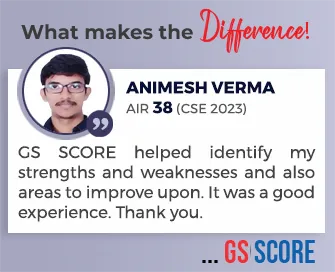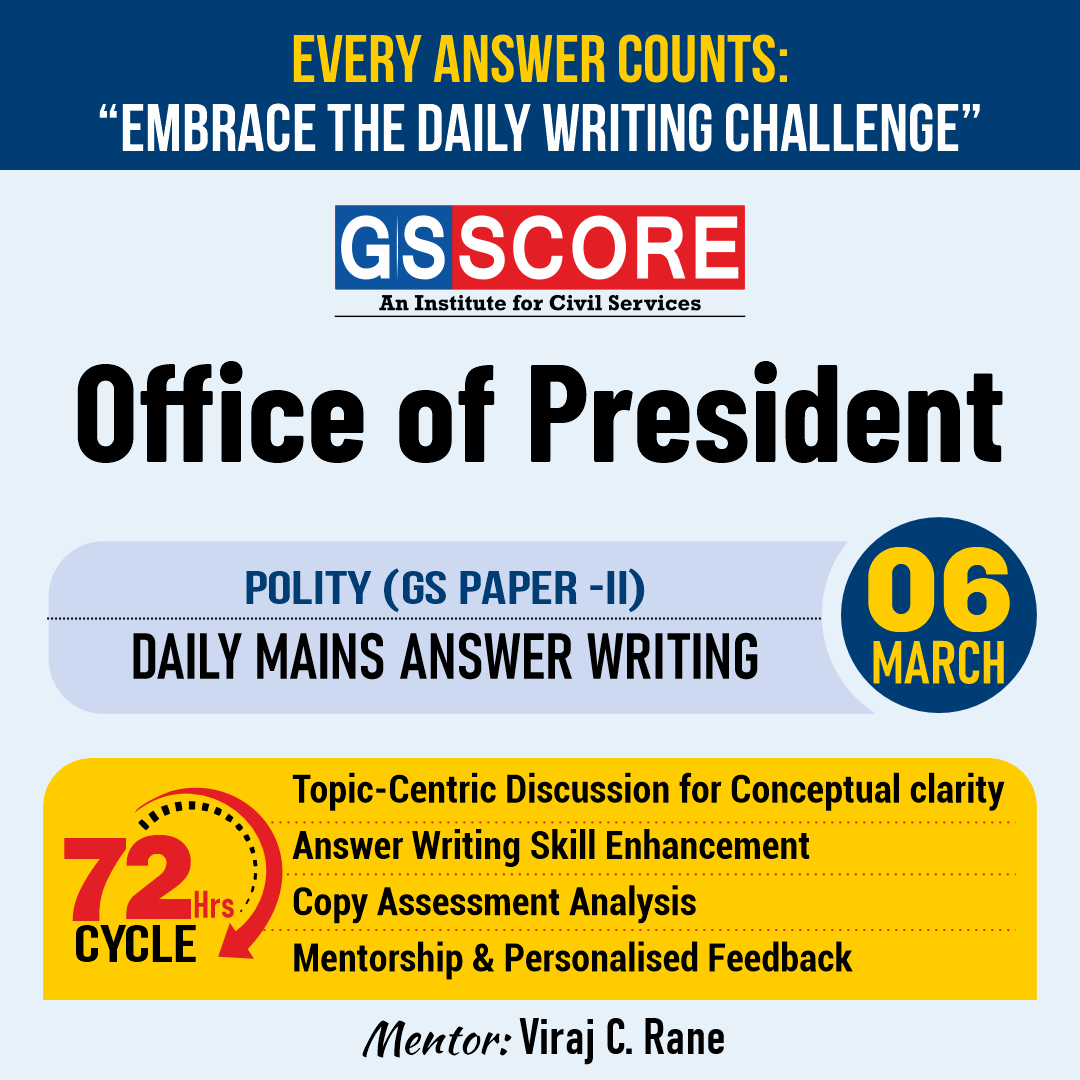


Instruction:
- There will be 2 questions carrying the First Question is-10 marks Write your answers in 150 words and the Second Question is-15 marks Write your answers in 250 words.
- Any page left blank in the answer-book must be crossed out clearly.
- Evaluated Copy will be re-uploaded on the same thread after 2 days of uploading the copy.
- Discussion of the question and one to one answer improvement session of evaluated copies will be conducted through Google Meet with concerned faculty. You will be informed via mail or SMS for the discussion.
Question #1. Why India didn’t adopt the Presidential form of government? Does India need the Presidential system now ? 10 marks (150 words)
Question #2. The Indian President should perform the function of an emergency light. Elaborate on the above statement taking into consideration the position of President of India’s office under the Constitution. 15 marks (250 words)
(Examiner will pay special attention to the candidate's grasp of his/her material, its relevance to the subject chosen, and to his/ her ability to think constructively and to present his/her ideas concisely, logically and effectively).
STEPS & INSTRUCTIONS for uploading the answers
Step 1 - The Question for the day is provided below these instructions. It will be available at 7:00 AM.
Step 2 - Uploading of Answers : Write the answer in A4 Sheet leaving proper margins for comments and feedback and upload the PDF in MY ACCOUNT section. Click on the option of SUBMIT COPY to upload the PDF.
Step 3 - Deadline for Uploading Answers: The students shall upload their answers by 7:00 PM in the evening same day. The first 50 copies will be evaluated.
Step 4 - Feedback : Mentors will give their feedback for the answers uploaded. For more personalised feedback, join our telegram channel by clicking on the link https://t.me/mains_answer_writing_cse . A one-to-one session will be conducted with the faculty after copy evaluation in 72 Hrs.
Model Answer
Question #1. Why India didn’t adopt the Presidential form of government? Does India need the Presidential system now? 10 marks (150 words)
Approach:
- Briefly introduce the salient features of the Presidential form of government.
- Discuss the factors which prevented India from going the 'Presidential' way.
- Analyse whether India should now go for Presidential system or not
- Briefly conclude with a balanced approach.
Hints:
The Presidential form of Government is a system in which the executive (including both the Head of the State and the ministers) is constitutionally independent of the legislature in respect to the duration of his or their tenure and irresponsible to it for his or their political policies. In this system, the President enjoys real powers of the government and is not responsible to the legislature for the administration and policies.
Why did India not go the 'Presidential' way?
- The decision of Parliamentary system of government was the result of a long discussion in the Constituent Assembly. Dr BR Ambedkar, the first law minister of independent India and principal architect of the Indian Constitution, was of opinion that, it was the American and not the British pattern which would suit the Indian situation.
- His main concern was how to establish a proper relation between the legislative and executive bodies in order that they might work independently and simultaneously and be answerable and cooperative with each other.
- He was not in the favour of an executive of the British type. In the British Parliament, he maintained, there is a political majority, but the majority in India is communal majority (heterodox social set up with multiple religion and culture). Hence, Ambedkar stood for a Parliamentary form of government because according to him, there were three features in the Parliamentary government:
- Under the American Presidential system, conflicts are bound to occur between the executive, legislature and judiciary; and on the other hand, according to many modern American writers, the absence of coordination between the legislature and the executive is a source of weakness in the American political system.
- India required a smooth form of government which would be conducive to the manifold development of the country without the least friction after attaining freedom from one and a half century of bondage. To this end, the Cabinet or Parliamentary system of government, of which India has already had some experience, was better suited than the Presidential form of government.
Does India need the Presidential system now?
- The Parliamentary system prevents conflict between legislature and executive and promotes harmony between the different parts of governmental system.
- The Presidential system centralizes power in one individual. However, in the Parliamentary system, the Prime Minister is first among equals. The surrender to the authority of one individual, as in the Presidential system, is dangerous for democracy.
- The over-centralization of power in one individual is something to guard against. Those who argue in favour of the Presidential system often state that the safeguards and checks are in place: that a powerful President can be stalled by a powerful legislature.
- But if the legislature is dominated by the same party to which the President belongs, a charismatic President or a “strong President” may prevent any move from the legislature. On the other hand, if the legislature is dominated by a party opposed to the President’s party and decides to checkmate him, it could lead to a stalemate in governance as both the President and the legislature would have democratic legitimacy.
- The switch demands bringing democracy in the intra-party functioning, maturity of the electorate, which is otherwise divided on caste and religious lines and removing the basic structure doctrine (Parliamentary form of government is part of the basic structure and cannot be removed).
Conclusion:
A diverse country like India cannot function without consensus-building. The “winner takes it all” approach, which is a necessary consequence of the Presidential system, is likely to lead to a situation where the views of an individual can ride over the interests of different segments. India must strive to work the best with what it has currently. The benefits of the Parliamentary form of government must be used for the best possible governance of the country.
Question #2. The Indian President should perform the function of an emergency light. Elaborate on the above statement taking into consideration the position of President of India’s office under the Constitution. 15 marks (250 words)
Concept/Syllabus Map Topic:
Structure, organization and functioning of the executive Sub-topic: Indian President
Approach
- The question requires analysis of the function of President
- Introduce the topic by writing about the functioning of the president's office as an emergency light.
- Elaborate why the term emergency light has been used.
- Analyse the functions, responsibilities aligning it with central theme.
- Conclude with the summary of your answer.
Hints:
President acts as an emergency light was coined by former president R. Venkatraman. Parliamentary system of government as envisaged in the constitution, president is only a nominal executive. He has only situational discretion which throws lights when there is a crisis and goes off automatically when the crisis ends.
President as a nominal head
1) Article 74 says there shall be a council of ministers with the prime minister at the head to aid and advice the President who shall in the exercise of his functions act in accordance with such advice.
2) Further, he represents the nation but does not the rule of nation. He can do nothing contrary to their advice nor can he do anything without their advice.
3) President appoints minister on the recommendation of prime minister.
4) Indirect election of the president is in harmony with being him as a nominal head because if there would have been direct election then, he could have been given real power.
Indian president performs the function of an emergency light as per the constitution:
1) Appointment of prime minister (article 75(1)) when no party has clear majority in the Lok Sabha.
2) When the prime minister dies and there is no obvious successor. (For example- in case of death of Indira Gandhi).
3) Dismissal of council of minister (article 75(2)) when it can’t prove the confidence of Lok Sabha
4) Dissolution of the Lok Sabha (article 85(2) (b)) if council of minister has lost its majority.
5) Pardoning power- He is the only authority to pardon death sentence and punishment or sentence by a court martial.
6) The President can ask for information under Article 78 of the Constitution about anything related to the Union Government. The Prime Minister is duty-bound to furnish such information and, if satisfied, the President can proceed against the prime minister.
In the case of Ram Jawaya Kapur Vs State of Punjab the Supreme Court stated that though the executive power is vested in the president the real power lies in the council of minster on whose advice president exercise his function.
It is one of the landmark cases dealing with the powers and functions of the executive. However, executive, legislative, financial, judicial, military and emergency power makes the Indian president head of the state and first citizen of the nation.



